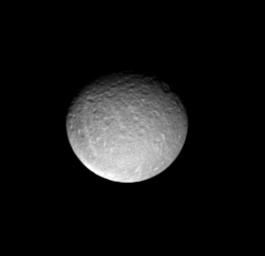
|
Rhea and Her Craters
- Click the image above for a larger view
- Full-Res JPEG (544 x 526) (9.8 kB)
- Full-Res TIFF (544 x 526) (71.5 kB)
Caption:
This Cassini image shows predominantly the impact-scarred leading hemisphere of Saturn's icy moon Rhea (1,528 kilometers, or 949 miles across).
The image was taken in visible light with the Cassini spacecraft narrow angle camera on Dec. 12, 2004, at a distance of 2 million kilometers (1.2 million miles) from Rhea and at a Sun-Rhea-spacecraft, or phase, angle of 30 degrees. The image scale is about 12 kilometers (7.5 miles) per pixel. The image has been magnified by a factor of two and contrast enhanced to aid visibility.
Background Info:
The Cassini-Huygens mission is a cooperative project of NASA, the European Space Agency and the Italian Space Agency. The Jet Propulsion Laboratory, a division of the California Institute of Technology in Pasadena, manages the mission for NASA's Science Mission Directorate, Washington, D.C. The Cassini orbiter and its two onboard cameras were designed, developed and assembled at JPL. The imaging team is based at the Space Science Institute, Boulder, Colo.
For more information about the Cassini-Huygens mission visit http://saturn.jpl.nasa.gov . For images visit the Cassini imaging team home page http://ciclops.org .
Cataloging Keywords:
| Name | Value | Additional Values |
|---|---|---|
| Target | Rhea | |
| System | Saturn | |
| Target Type | Satellite | |
| Mission | Cassini-Huygens | |
| Instrument Host | Cassini Orbiter | |
| Host Type | Orbiter | |
| Instrument | Imaging Science Subsystem (ISS) | |
| Detector | Narrow Angle Camera | |
| Extra Keywords | Crater, Grayscale, Impact, Visual | |
| Acquisition Date | ||
| Release Date | 2005-01-17 | |
| Date in Caption | 2004-12-12 | |
| Image Credit | NASA/JPL/Space Science Institute | |
| Source | photojournal.jpl.nasa.gov/catalog/PIA06564 | |
| Identifier | PIA06564 | |
